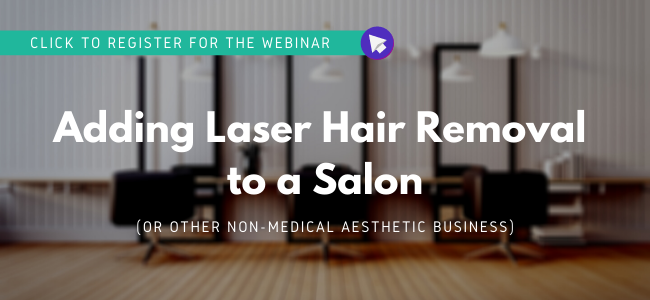If you’re an aesthetic practitioner considering adding laser hair removal to your business, you may have questions about its technology, effectiveness, and procedure. Becoming an expert in your laser technology is important to gain confidence in performing laser hair removal and answering any questions your clients may have.
Astanza has compiled a list of the most frequently asked questions about laser hair removal – and the accompanying answers – to help guide practitioners as they navigate this information and educate their clientele. Keep reading this article to learn more about laser hair removal and how you can provide the best possible experience for your patients.
1. How Does Laser Hair Removal Work?
A laser hair removal device uses light energy to destroy actively growing hair follicles by targeting their color, or melanin. The melanin in the hair follicle absorbs the laser’s light energy, which then destroys the root of the hair.
There are three stages of growth for hair: Anagen, catagen, and telogen. Laser hair removal works more effectively when hair follicles are targeted in the anagen phase, the growing stage of the hair. Since each hair on the body can be at a different growth phases simultaneously, it’s necessary to treat the unwanted hair area multiple times. This way, each hair follicle is targeted during its growth stage, providing optimal long-lasting hair reduction results.
2. Is Laser Hair Removal Safe?
Patient safety should be a top priority for an aesthetic business when performing laser hair removal. Investing in a hair removal device that is safe for all skin colors and hair types is essential to providing the most effective and quality laser hair removal procedures. Avoid laser technology claiming to be an all-in-one device, such as having the ability to provide both tattoo removal and hair removal. There are various wavelengths when it comes to aesthetic laser devices and their accompanying procedures, and the proper wavelength for hair removal is not the same as the proper wavelength for tattoo removal.
To best remove unwanted hair, diode lasers with a wavelength of around 800 to 810 nm precisely target the hair follicle. Laser technology with 1064 nm wavelengths remove pigment in the skin, such as tattoo ink. Using an aesthetic laser device with a 1064 nm wavelength to attempt to remove hair creates a significant risk, especially for darker skin types, due to the incorrect laser wavelength utilized.
The Asclepion MeDioStar®, backed by Astanza, is a great example of a safe hair removal device that effectively treats all skin types. This diode laser technology combines two wavelengths (810 nm and 940 nm) to reach even the deepest follicles. This wavelength duo, the device’s variable pulse length, and an integrated 360° contact skin-cooling system guarantee a safe treatment for all skin types (Fitzpatrick scale I-VI), including recently-tanned skin. Learn more about the MeDioStar®’s features, specs, handpieces, treatment capabilities, and profitability by watching our on-demand Inside the Laser webinar episode. Click the link or the image below to get a downloadable version sent to your inbox.
3. How Many Sessions Are Needed?
To achieve desired laser hair removal results, most patients need an average of five to eight treatments spaced four to six weeks apart to properly target and destroy the hair follicles during their growth stage. Some patients may need a few more sessions, more in the six to 10 range, to achieve permanent hair reduction. It’s important to note that every laser hair removal patient is different and treatment results may vary, depending on the individual’s hair color, skin type, and other related health factors.
4. Who Is a Good Candidate for Laser Hair Removal?
Laser hair removal is a sought-after treatment among both men and women of all ages. With the help of advanced laser technology like the MeDioStar®, it is now possible to safely and effectively treat a vast range of skin types and hair colors. However, it can be challenging to remove lighter hair colors as lasers target hair pigment. We recommend offering free consultations to all patients, but especially for those with blonde, red, or gray hair to determine if laser hair removal is a suitable option for them.
5. How Can a Hair Removal Device Increase Med Spa Profits?
As the popularity of hassle-free methods of removing unwanted hair increases, so does the demand for laser hair removal. Adding advanced laser technology for hair removal automatically expands your potential clientele base, creating a new stream of revenue for your aesthetic laser business. On average, underarm hair removal treatments are priced at about $150 per session. Other larger areas, such as the back, can cost around $300 to $800 per treatment. Since a completed treatment plan for laser hair removal can take about eight sessions, you can increase your med spa profits by up to $6,400 per client!
With additional handpieces, your laser hair removal device could also perform other FDA-cleared treatments proven to be successful. For example, the MeDioStar® has an optional vascular handpiece with a 940 nm wavelength to treat vascular lesions effectively. On average, a vascular laser treatment costs about $300. To fully remove a lesion, a patient would need around one to three laser treatments. With these vascular lesion removal averages in mind, your med spa can gain yet another stream of revenue, in addition to laser hair removal, and earn around $900 per vascular lesion removal patient.
Become Part of the Astanza Family
Ready to take the next step in your aesthetic laser business? Contact Astanza today to learn how to add the diode MeDioStar® laser hair removal device to your practice; increasing client satisfaction and clinic profitability.



